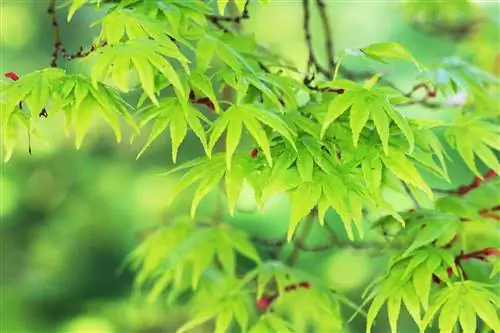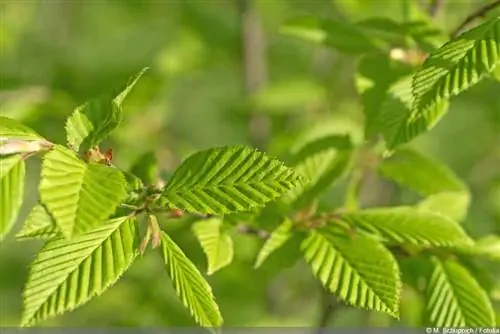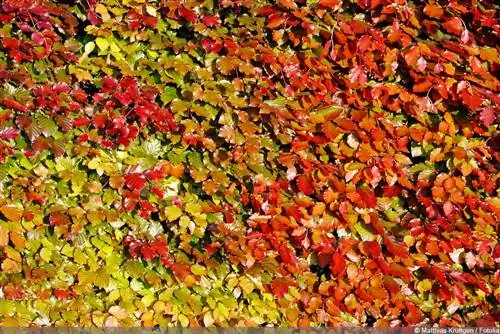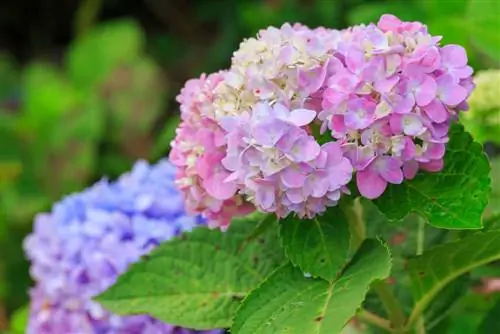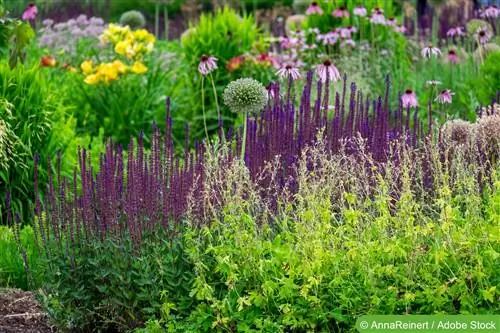- Author admin [email protected].
- Public 2023-12-17 03:39.
- Last modified 2025-01-24 12:45.
The beech (Fagus) is one of the most popular plants in this latitude. Whether as a shrub, hedge or tree, it not only adorns public parks and facilities, but often also your own garden. As a tree, the wood is particularly fascinating because of its original growth, which should not be destroyed even after it has been cut. Caring for the beech tree is also easy and can be done with little time.
Care
Caring for beech trees is very easy. Because it is a native forest tree and therefore requires little attention, even in your own garden. Watering and fertilizing are usually very minimal. Before planting, however, it is important to consider that the tree will reach an impressive height. Therefore, there must be enough free space available at the chosen location. Other trees, the house or other obstacles should not be in the immediate vicinity. However, a young tree remains relatively small for the first ten years; the beech only reaches its full impressive size after about 30 years. In addition, beech trees are so-called shallow-rooted trees that also require enough space on the ground to spread. If you don't want a tree to grow that big, the roots can be restricted in growth.
Profile
- Common Beech
- Botanical name: Fagus sylvatica
- native to all temperate regions of the northern hemisphere
- Beech family (Fagaceae)
- lat. Name Fagus
- Life expectancy up to 300 years
- Beechnuts only from the age of 30
- also suitable as a hedge plant
- as a tree up to 45 meters high
- frost hardy down to -30° Celsius
- Shallow-rooted
- lime-loving
Soil conditions & location
Since the beech tree can reach a height of up to 45 meters, it naturally needs a sufficiently large location with enough space for the expansive tree crown and the shallow-growing roots. The location and the soil condition should look like this:
- sunny to partially shaded
- spacious location
- young beech trees protected from the wind
- sandy to gravelly and loamy soil
- always slightly moist and fresh
- permeable
- pH value between 6.5 to 8 is ideal
- calcareous
Fertilizing & Watering
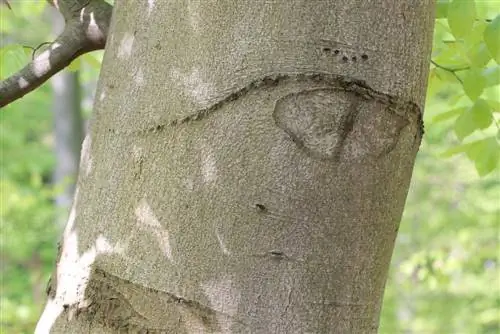
Like all native tree species cultivated in forests, the beech does not require any special care in terms of fertilization and watering. If it is particularly hot in a summer, you can water it every now and then. If the beech tree is planted together with its neighbors, this is recommended for the reason that they do not dry out. Otherwise, pay attention to the following:
- water young beeches regularly
- especially in the planting year
- even in winter on frost-free days
- in a long dry period
- Mulch around the tree replaces fertilizer
- fertilize young trees with compost in spring
- raking fallen leaves around the roots in autumn
Tip:
If you don't pick up all the fallen leaves in autumn, but rather rake them over the roots around the trunk, then these can serve as natural fertilizer and the forest floor is recreated.
Harvest time
Beeches can live up to 300 years. It takes a correspondingly long time for them to form the first flowers and thus also the fruits, the beechnuts. A beech tree has to be around 30 years old before a beechnut harvest can be expected. Since these usually only serve as food for small wild animals, this is not a big deal. The tree is very decorative even without the already very inconspicuous formation of flowers.
Diseases & Pests
Beech trees are unfortunately somewhat susceptible to various diseases and pests. The thin bark and the superficial roots can quickly be attacked by parasites. These include the beech slime fungus and the burn crust fungus, which attaches itself directly to the base of the trunk. The fungus is so dangerous because it affects the stability of the tree. If these cases occur, an expert from the forestry sector should be consulted. But the following pests can also settle on the beech tree:
- Scale insects
- on the underside of the leaf
- small trees cum
- big trees lose their leaves
- rake up all leaves and dispose of them in the trash
- burn alternatively
- spray entire tree with insecticide
Plants
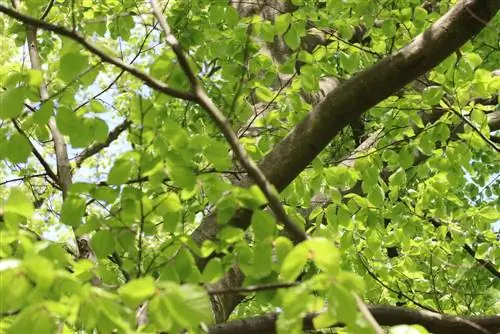
The ideal planting time for the beech tree is in autumn in October, when the earth is still slightly warm and frosty nights are not expected immediately. Then the young plant can root well before the coming winter. If this point is missed, planting can also take place in the spring before budding. When planting, pay attention to the following:
- Removing the tree from the container
- Put bale and container goods in a water bath
- Can be omitted for bare root trees
- Dig out a planting hole twice as large as the root ball
- Prepare soil with compost
- stones on the bottom of the planting hole as drainage
- Insert tree
- Insert stand aid directly
- fill in prepared soil
- water well
Plant Neighbors
Since the beech tree grows very large, it needs the right plant neighbors that can survive shade well and decorate the space under the tree. Because lawn cannot be cultivated around the tree in the immediate vicinity. The following neighbors are particularly suitable as underplanting:
- Ferns
- Primroses (Primula)
- Foam flowers (Tiarella cordifolia)
- Forest Lilies (Trillium)
Wintering
Only the young, recently planted beech trees need light winter protection. To do this, the area above the roots is sufficiently mulched. The trunk can also be wrapped with brushwood mats in the first few winters. The older, well-rooted beech no longer needs any winter protection. However, mulching is not only advisable in winter, but all year round. Mulch protects against too much sun and frost and keeps the soil moist longer.
Cutting
If the beech is planted as a solitary tree in a garden with plenty of space, no pruning is usually required. The uncut treetop in particular looks very decorative when left uncut. If a cut is still necessary because there is no longer enough space, the plant is affected by a disease or the beech tree has become too large overall, it can of course be cut back. However, a few things must be taken into account, such as the right tools, the right time and the right cut.
Appropriate timing
The right time to cut is usually in the spring before budding. This is mainly because the beech tree produces a lot of sap when it sprouts. If you cut it later, there would be a risk that the tree would lose too much sap and bleed. When choosing the cutting time, pay attention to the following:
- choose a frost-free, overcast day
- Sun burns the interfaces
- when it rains, moisture gets in
- light pruning also possible in July
- only remove small branches
Tip:
However, if the beech tree is suffering from a disease, then the timing is irrelevant; in such a case, you should remove the affected branches immediately.
Right tool

It is also important to have the right tools when pruning a beech tree so that the tree is not damaged. If there are frayed areas caused by unsharp saws or if the tool used has not been cleaned sufficiently, illness can occur. Bacteria, fungi or viruses could penetrate the entire tree through the interface and thus cause massive damage. Therefore, you should pay attention to the following when using the tool:
- for thicker branches pruning saw
- alternatively chainsaw
- Pruning shears for thin branches
- check before use
- sharpen if necessary
- always clean well before cutting
- disinfect afterwards
- use pure alcohol from the pharmacy
Note:
Even if you cleaned and disinfected the cutting tool last autumn and put it away in a dry place, you should still not forego cleaning and disinfecting it again before cutting the beech. During storage, bacteria, viruses or fungi could have settled on the cutting surface and then penetrate the tree through the interfaces.
Right Cut
As a rule, the crown of the beech should be reduced a little with one cut. So that the interface is not visible for too long, it is important to cut the appropriate branches here. You should proceed as follows:
- shorten only the side branches
- a side branch should always remain at the end
- so the tree can sprout again
- Interfaces become invisible after a short time
- shorten fully grown beech trees by only 2.50 meters
- Do not prune the crown too much
- Trunk should not be exposed to the sun
- thin beech branches contribute to the supply of nutrients
- so don't shorten these too much
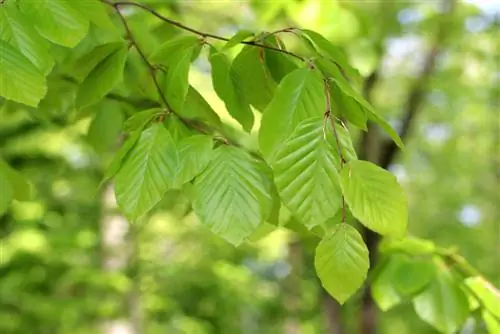
For a fully grown beech, the shortening should not exceed 2.50 meters. If the tree needs to be cut back more because it is still too big, the cut must be done over several years. It is better not to let the beech tree get too big in the first place.
Note:
The beech tree is only fully grown when it is around 40 years old. As a solitary tree, the tree usually does not need any pruning beforehand. However, you should check with your municipality about the nature conservation requirements for pruning large trees if you don't just want to remove a few individual branches.
Cutting young beech trees
If a beech tree has been newly planted, it should now receive its first cut. The goal here is for the new tree to develop better branching and new shoots in the spring. The first cut should be done as follows:
- Short the crown by a third
- always above one eye
- leave at least three buds on the shoot
- water well after cutting
- Avoid waterlogging
Tip:
If you have a shredder, you should chop up all the beech cuttings and distribute them under the tree and on your other garden beds. Beech cuttings make an excellent mulch.
Cutting damaged tree
If a damaged tree needs to be cut, this can be done at any time of the year. It is better to remove the damaged branches and twigs from the tree than to leave them on the tree for a long time. A cut may become necessary due to an illness, for example a fungal infection. An autumn storm can also cause major damage to the tree. If the beech tree needs to be cut to save it, you should proceed as follows:
- remove all damaged or infected branches
- as necessary
- Seal large interfaces with tree wax
- alternatively use artificial tree bark
Note:
Whenever you need to prune between spring and fall, you should check the treetop for bird nests. If there are breeding birds here, you must postpone the cut in accordance with the Nature Conservation Act.


